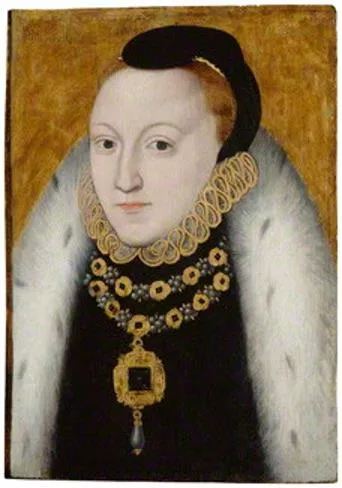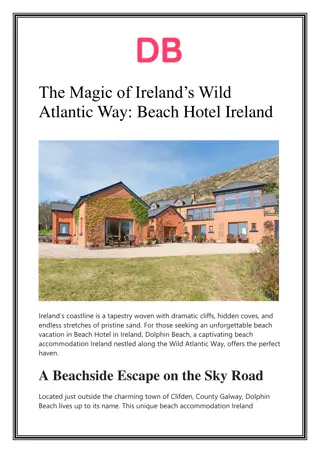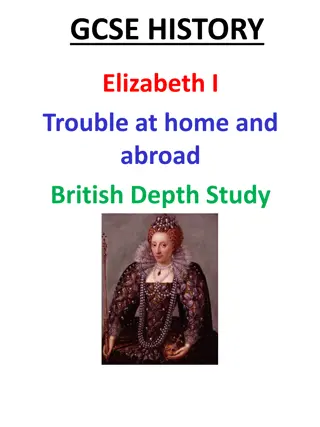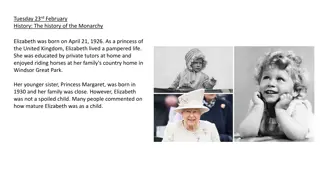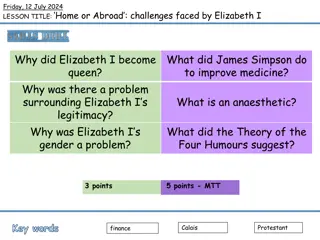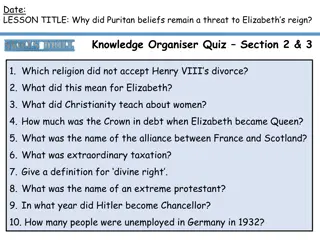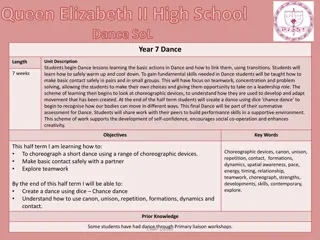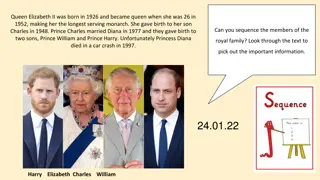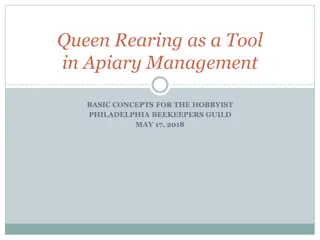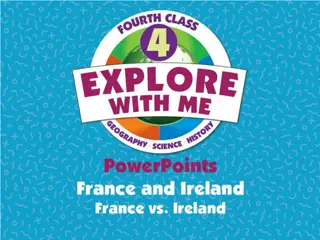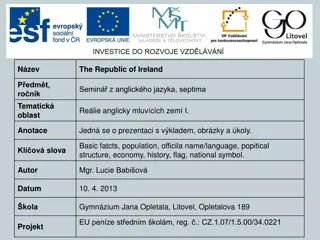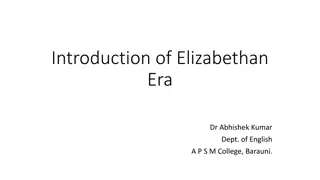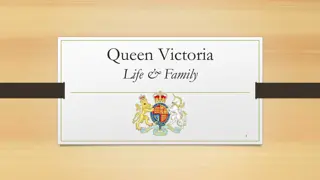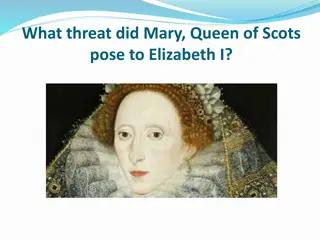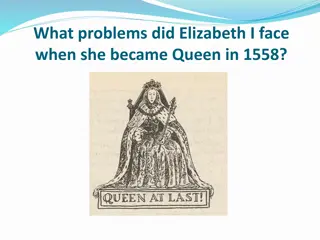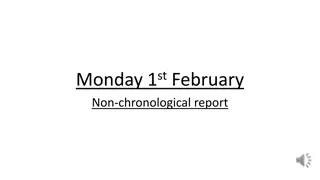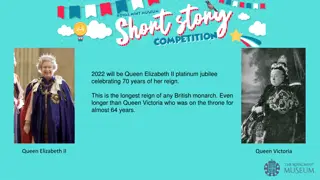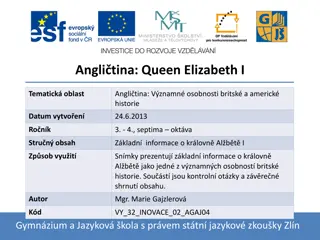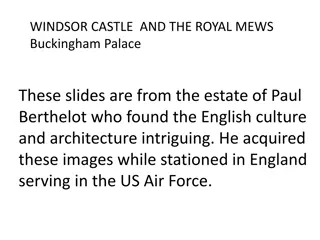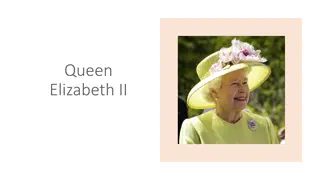History of Ireland and Queen Elizabeth I
Mesolithic hunter-gatherers migrated to Ireland in prehistoric times, followed by Celtic influence during the Iron Age. The history includes Viking raids, Henry II's arrival in Ireland, the Treaty of Windsor, the Great Charter of Ireland, the establishment of the First Irish Parliament, and events leading up to the reign of Queen Elizabeth I, who played a significant role in transitioning England to Protestantism.
Uploaded on Sep 11, 2024 | 2 Views
Download Presentation

Please find below an Image/Link to download the presentation.
The content on the website is provided AS IS for your information and personal use only. It may not be sold, licensed, or shared on other websites without obtaining consent from the author.If you encounter any issues during the download, it is possible that the publisher has removed the file from their server.
You are allowed to download the files provided on this website for personal or commercial use, subject to the condition that they are used lawfully. All files are the property of their respective owners.
The content on the website is provided AS IS for your information and personal use only. It may not be sold, licensed, or shared on other websites without obtaining consent from the author.
E N D
Presentation Transcript
Brief History of Ireland Mesolithic hunter-gatherers migrate to Ireland in prehistoric times and begin farming and keeping livestock Celtic influence was present during the Iron Age Written reference to Dublin area settlement in 140 Palladius is sent as the first Bishop by Pope Celestine 429 St. Patrick returns in 432 Annals of Ulster Viking raids in 795 Henry II lands and declares himself Lord Of Ireland 1171
Brief History of Ireland (cont) 1175 Treaty of Windsor Henry II left Rory to rule most of Ireland Henry II
Background (cont) 1216 Great Charter of Ireland by Henry III Secured rights for Anglo-Normans of Ireland 1297 First Irish Parliament 1366 Statutes of Kilkenny to curb the decline of Hiberno-Norman Lordship of Ireland 1579 Second Desmond Rebellion 1594 Nine Years War Hugh O Neill 1609 Plantation of Ulster
Predecessors to Elizabeth Papal Bull for Henry II to Conquer Ireland 1155 Henry VIII
Predecessors to Elizabeth (cont) 1494 Poyning s Law no law without consent of English Parliament 1534 Thomas Fitzgerald renounced allegiance to Henry VIII drawn and quartered 1542 Crown of Ireland act Irish Parliament to be ruled by Henry VIII Mary I followed Mary was Catholic. Bloody Mary??? Henry VIII Queen Mary I
Elizabeth I Elizabeth basic information; Link to Royal Government biography Skilled politically. Was able to survive Mary s reign. Was brought to Treason Gate but refused to enter tower Said she was an innocent subject of the Queen but eventually entered. She was released when Mary became pregnant. Protestant taking over from Catholic Mary Returned England to Protestant Religion
Elizabeth I (cont) Parliamentary Acts 1559 Act of Supremacy Supreme Governor of the Church of England, and instituted an Oath of Supremacy, requiring anyone taking public or church office to swear allegiance to the monarch as head of the Church and state. Anyone refusing to take the Oath could be charged with treason.
Elizabeth I (cont) Act of Uniformity 1559 Set order of Prayer Everyone had to go to Church Once a Week or Pay a fine. 1570 Pope Pius issued Renans in Excelsis declaring Elizabeth a heretic and releasing her subjects from allegiance. Penal Laws Set punishments for Catholics during Protestant time Queen Elizabeth I
Ireland at the time and changes Ireland in 1558 was divided politically and culturally into English and Gaelic parts. The predominantly Gaelic west and north had a scanty, shifting population, with scattered, largely impermanent settlements, and a predominantly pastoral economy. The smaller, more 'civil', 'Englishry' (the English Pale around Dublin and the south) contained numerous English-style towns and villages and prided itself on its Englishness and loyalty. Yet Gaelic practices and speech were spreading among those of English descent (the future Old English) and the costs of defending the queen's subjects there had lately escalated alarmingly.
Ireland at the time and changes (cont) English landowners still lived in defended towerhouses (outside the towns and the inner Pale), their tenants (and many Gaelic clansmen) in wattle and daub cabins. Elizabeth personally expressed a desire to learn Gaelic, and demanded a Gaelic translation of the New Testament from her bishops - in line with the Protestant insistence on the use of the vernacular in church services - but others feared that Gaelic services would undermine the government's programme to make Ireland English.
Policy and Reaction Elizabethan policy towards Ireland was predominantly reactive, but there were also some new initiatives to extend English rule. Perhaps the most successful was the establishment in Connaught and Munster in 1569- 70 of regional councils (or presidencies), along the lines of those in Wales and the English north. Initially, their intrusion antagonised local magnates, particularly in Munster where the earl of Desmond's cousin, James Fitzmaurice, tried to whip up Catholic opposition and appealed unsuccessfully for Spanish support. Later, however, the councils became self-financing through the device of composition.
Policy and Reaction (cont) Its English equivalent, purveyance for the army and governor's household, was also commuted, so reducing the queen's overall charges but generating fierce resentment in the Pale where it was seen as a new, unconstitutional, system of military taxation, levied without the subject's consent.
Sommerville Paper on Elizabeth and Ireland Mary I sent Thomas Radcliffe, 3rd Earl of Sussex as her Lord Lieutenant. Radcliffe soon came into conflict with the MacDonnells (O'Donnells) clan - settlers of Scottish descent in Ulster. Thomas Radcliffe, 3rd Earl of Sussex (1526? - 1583)
Sommerville Paper on Elizabeth and Ireland (cont) Radcliffe during 1557 defeated rebels in Leix and Offaly. Territory there and other land west of the Pale was confiscated and given to English settlers. Radcliffe also fought a number of unsuccessful engagements against the Ulster chieftain, Shane O'Neill. Radcliffe's uncompromising approach to the locals created resentment in the Pale, and he was removed in 1564.
TBD 16th century Ireland
Elizabeth and Ireland In 1565 Elizabeth I replaced Radcliffe as Lord Deputy with Sir Henry Sidney (1529-86). Sidney's policies were still more assertive of English authority: he aimed to destroy Gaelic power in Leinster and Scottish power in Ulster. Sir Henry Sidney s Memoirs
Elizabeth and Ireland (cont) Sidney s policies had some success colonizing Munster but eventually led to a major rebellion led by the Earl of Desmond (Fitzgerald). Several years of fighting ensued along with an invasion by a small force of Italian and Spanish troops. Arthur Lord Grey eventually suppressed the revolts in Munster and the Pale. Sir Henry Sidney
Elizabeth and Ireland A Second Rebellion the Nine Years War (1594 1603) / Tyronne Rebellion with the native Catholics vs. Protestant English. The rebels had victories at Yellow Ford and Clontibert. They were eventually defeated by Mountjoy at the siege of Kinsale. Elizabeth's victory over the Irish cost a great deal of money. It cost about 2 million to suppress the revolt; 1.25 million of it over the period 1599-1603. The military victory did nothing to reconcile the Irish to English rule, and the success of Catholic missionary priests reinforced the religious dimension of the struggle. The English succeeded in denying her Catholic enemies a strongpoint off her Western Coast, but only military force would maintain Ireland's subjection for many centuries to come.
Prologue Rebellions occurred. The most significant of the Middle Ages led to Irish and Jacobite defeat at the Battle of the Boyne by William of Orange s army . Irish Free State Declared December 6, 1921 Northern Ireland (Ulster) remains part of the United Kingdom to the present day. Irish Martyrs 1 Irish Martyrs 2 Irish Martyrs 3 EWTN


